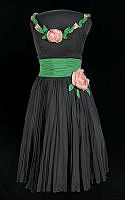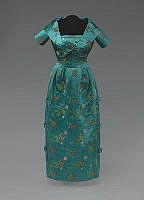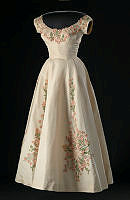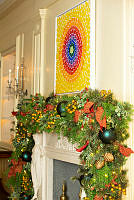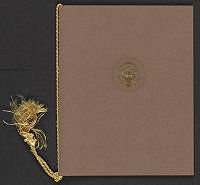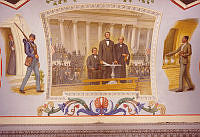Rubenstein Center Scholarship
Slavery and French Cuisine in Jefferson's Working White House
This article is part of the Slavery in the President’s Neighborhood initiative. Explore the Timeline
President Thomas Jefferson was widely recognized as a Francophile, embracing all things French including art, culture, and custom. While serving as Minister to France from 1784 to 1789, Jefferson developed a particular taste for French cuisine. However, French chefs were very expensive to employ, and Jefferson’s costs regularly outpaced his income. While Jefferson may have been short on cash, he did have an abundant supply of readily available enslaved labor, bound to serve him for life. To save money, Jefferson employed French chefs to train several enslaved members of the Monticello community in the delicate art of French cookery. These enslaved chefs received the best training France had to offer and they received a modest cash allowance. However, they were tasked with the grueling work of cooking elaborate meals for Jefferson in France, New York, Philadelphia, at Monticello, and the White House and lacked the freedom to come and go as they pleased.1 Click here to learn more about the enslaved households of President Thomas Jefferson.
The first enslaved person Jefferson sought to train as a French chef was James Hemings, the brother of Sally Hemings. In May 1784, as Jefferson made arrangements to join John Adams and Benjamin Franklin in France as American Minister to the French court, he summoned Hemings to accompany him on the journey. He sent instructions to his soon-to-be secretary William Short: “I propose for a particular purpose to carry my servant Jame with me.”2 Hemings soon joined Short, Jefferson, and his eldest daughter Martha for their voyage, departing from Boston on July 5, 1784.3 Click here to learn more about the household of President John Adams.
Once in France, Jefferson’s “particular purpose” became clear and Hemings began training in the art of French cookery.4 First, he studied with caterer and restaurateur Monsieur Combeaux until February 1786.5 After covering the basics with Combeaux, Hemings learned French pastry and apprenticed with several pastry chefs, including a chef in the household of the Prince de Condé.6 Upon completion of these apprenticeships, Hemings became the head chef at Jefferson’s place of residence, the Hôtel de Langeac. In this position Hemings earned twenty-four livres a month, half of what Jefferson paid his previous chef cuisinier.7
Hemings experienced France during a period of political unrest which would ultimately culminate in the start of the French Revolution in 1789. During this time, Hemings was certainly exposed to discussions of rights and freedoms. In fact, under French law, Hemings could petition the courts to obtain his freedom despite the fact that he was brought from a different country. Ultimately, Hemings chose not to pursue his freedom through this channel and instead returned to the United States as an enslaved man in October 1789 with Jefferson and his sister Sally.8 Hemings chose to return with Jefferson based, at least in part, on Jefferson’s pledge to free him if he worked as Jefferson’s chef at home for a period of time.9

An inventory of kitchen utensils at Monticello conducted February 20, 1796 by James Hemings.
Library of CongressHemings continued in his position as chef when Jefferson moved to New York and Philadelphia to serve as the Secretary of State under President George Washington. During this time, he earned a monthly wage of seven dollars, the same amount Jefferson paid his free domestic staff members. When Jefferson’s tenure as Secretary of State came to an end in December 1793, James bargained for his freedom. The resulting manumission agreement stated that Hemings would return to Monticello to train another enslaved person in French cooking to serve as a replacement chef. Once the replacement chef was properly trained, Jefferson agreed that Hemings “shall be thereupon made free, and I will thereupon execute all proper instruments to make him free.”10 Click here to learn more about the enslaved households of President George Washington.
When he returned to Monticello, Hemings trained his brother, Peter Hemings, to take his place and on February 5, 1796, James obtained his freedom. In the deed of manumission, Jefferson stated, “I Thomas Jefferson of Monticello aforesaid do emancipate, manumit and make free James Hemings, son of Betty Hemings, which said James is now of the age of thirty years so that in the future he shall be free and of free condition, and discharged of all duties and claims of servitude whatsoever, and shall have all the rights and privileges of a freedman.”11
After his brother’s manumission, Peter Hemings took over as the chef at Monticello. However, when Jefferson was elected to the presidency, he made different arrangements for the White House. Initially, Jefferson hoped that James Hemings would come to the Executive Mansion as a free man and work as the head chef. At this point, Hemings worked as a chef in Baltimore. Jefferson contacted Hemings indirectly, offering him the job of chef de cuisine through an intermediary. On February 23, 1801, Jefferson received a letter from former employee Francis Say stating that James Hemings would be willing to serve as chef but that he “would be very much obliged to you if you would send him a few lines of engagement and on what conditions and what wages you would please to give him with your own handwriting.”12 Jefferson declined to contact Hemings directly and as a result, James did not bring his skills to the White House. According to historian Annette Gordon-Reed, Jefferson likely knew that Hemings request for direct correspondence was about more than a piece of paper. It was about being treated as a free man by his former owner. Jefferson refused to acknowledge his freedom in this capacity and as a result, Hemings refused to acquiesce to Jefferson’s request.13 On recommendation from French consul Phillippe de Letombe, Jefferson instead hired French chef Honoré Julien to serve as the White House chef de cuisine.14
Although there is no further evidence of correspondence between Jefferson and Hemings, they did resolve their relationship to some extent because James Hemings cooked for Jefferson at Monticello in August of 1801 when the president returned home for his summer retreat. Surrounded by his family, Hemings earned twenty dollars a month for this work. When he left Monticello that fall, it was the last time his family or Jefferson would see him alive. A few months later, President Jefferson received word that James Hemings tragically died by suicide.15
After Hemings successfully bargained for his freedom, Jefferson made an effort to keep the enslaved population of Monticello separate from the White House for fear they too would hear more talk of freedom and equality.16 For the most part Jefferson preferred to employ white staff members at the Executive Mansion, writing in 1804, “I prefer white servants, who, when they misbehave, can be exchanged.”17 During his time at the White House, Jefferson only brought enslaved teenage girls from Monticello to train as cooks under the direction of Chef Honoré Julien, similar to the way James Hemings trained under chefs in France. This choice was strategic.
"Jefferson refused to acknowledge his freedom in this capacity and as a result, Hemings refused to acquiesce to Jefferson’s request."
Historian Annette Gordon-Reed suggests that Jefferson’s very traditional views on the roles of men and women caused him to believe teenage girls were less likely to cause problems within the White House than teenage boys. In addition, Jefferson chose young girls who already had strong ties to families and men back at Monticello, thus creating an additional incentive for them to refrain from pursuing avenues to freedom as James Hemings had done.18 All of this was done to prepare Jefferson for his post-presidency retirement at Monticello. Jefferson liked the idea of training his enslaved household staff to cook fine French meals in order to afford him the luxury of French dining at home on his Monticello plantation without the expensive labor costs.19 In addition, using the labor of enslaved chefs created a more reliable labor pool. Unlike a French chef, who could leave Monticello at any time, an enslaved chef was bound to continue working for Jefferson.
In 1801, Jefferson brought fourteen-year-old Ursula Granger Hughes to the President’s House to train as Monticello’s new cook. Ursula had significant family ties to Monticello’s enslaved community. Her husband, Wormley Hughes, was the nephew of Sally Hemings, and Ursula herself was the granddaughter of George and Ursula Granger, known as the “King” and “Queen” of Monticello. As the granddaughter of Ursula Granger, the head cook at Monticello before the Hemings brothers took over, Jefferson brought her to the White House to train like her grandmother before her.20
Ursula did not stay at the White House very long. She was first listed in Jefferson’s account books in November 1801. By the time she arrived, she was already several months pregnant.21 Jefferson noted the expense of her “lying in” in his memorandum book entry for March 22, 1802, meaning that she gave birth to her first child sometime before that date.22 While it is often reported that Martha Jefferson Randolph’s son, James, was the first child born in the White House, Ursula's child was actually the first baby born in the residence.23
The challenges of giving birth and then raising a newborn were difficult for Ursula, and her apprenticeship with Honoré Julien proved unsuccessful. In June 1802, Jefferson wrote to his daughter about sending Ursula home to Monticello: “I hope Peter Hemings will get the better of his complaint, or I know not what we should do, as it is next to impossible to send Ursula & her child home & bring them back again.”24 Jefferson hoped Peter Hemings would recover quickly from an apparent illness or injury so he could return to his duties as Monticello’s head chef. If Hemings recovered, then Jefferson could avoid bringing Ursula back to Virginia. He also indicates that the journey would have been extremely difficult. Since Jefferson and several enslaved individuals regularly completed the journey between Washington and Monticello, Jefferson’s hesitancy suggests that the baby was in poor health. A few weeks later, Jefferson’s account book entry for July 13, 1802 contains a note to pay “the man who is to carry P. Carr’s carriage & Ursula.”25 At that point, Jefferson was still planning to send Ursula home. It is unclear whether she was returning to briefly fill in for Peter Hemings or whether it was to be a permanent move back to Monticello.

This document represents Jefferson’s account with Doctor Edward Gantt for services provided “To Ursula” on March 22, 1802 and “To her child from April 2nd to May 13th.”
Library of CongressHowever, another letter sent by Étienne Lemaire to Thomas Jefferson on August 17, 1802 may provide some answers: “Sir, the poor child Asnet died on the 14th of this month, but I assure you that the good Lord rendered a great service to him and to his mother, since he would have been infirm all his life.”26 Although Lemaire does not say the name of the unfortunate Asnet’s mother, there is no record of another baby born at the White House during 1802. Lemaire was writing to Jefferson from the President’s House while Jefferson spent his summer at Monticello. If Asnet was indeed Ursula's son, he was likely too sick to travel back to Monticello when Jefferson intended to send them home in July. According to Lemaire, the baby died on August 14 at the White House and his statement about Asnet being “infirm all his life” suggests that the child was born with some type of medical condition that would have made his survival unlikely. If Asnet’s mother was Ursula, he was both the first child born and the first child to die in the White House. Ultimately, we know Ursula returned to Monticello and that her child did not live to adulthood. Upon her return, she assisted in the kitchens and the fields and went on to have nine more children with her husband, Wormley.27
After Ursula returned to Monticello, Jefferson replaced her with another teenage girl. Fifteen-year-old Edith (Edy) Hern Fossett arrive in the fall of 1802 to train under Julien. 28 Like Ursula, Edith had strong ties to Monticello’s enslaved community. She was the daughter of David Hern, an enslaved carpenter, and Isabel Hern, a lady's maid and farm laborer. At the time she left for the White House, Edith was married to Joseph Fossett, an enslaved blacksmith at Monticello.29 Several years later in the fall of 1806, another teenage girl with strong ties to Monticello, eighteen-year-old Frances (Fanny) Gillette Hern, known as Fanny, joined her sister-in-law Edith at the White House. Frances was the daughter of Edward and Jane Gillette, enslaved farm laborers. Her husband, David Hern, was an enslaved nail maker, blacksmith, and wagon driver.30
Both girls remained at the White House until Jefferson left office in 1809. They worked alongside the rest of Jefferson’s staff which, in addition to Chef Honoré Julien, included mâitre d'hôtel Étienne Lemaire, an enslaved footman named John Freeman, and several other servants. Unlike the free staff, who were paid wages for their services, Edith and Frances were allotted a customary gratuity of $2.00 a month as “drink” money. This was their only form of payment for their services. However, this small amount likely allowed the girls to participate in Washington life to a certain extent.31
"If Asnet’s mother was Ursula, he was both the first child born and the first child to die in the White House."
As apprentice chefs to Honoré Julien, they worked in the White House kitchen, preparing meals for between ten and fourteen people. Edith and Frances became skilled in the French style of cooking, managing a temperamental open hearth that varied wildly in temperature as they constantly moved around dishes to expose them to the proper amount of heat.32 Jefferson’s numerous dinner guests praised the delicious courses cooked at the White House. Washington resident Margaret Bayard Smith recalled, “The excellence and superior skill of his [Jefferson’s] French cook was acknowledged by all who frequented his table, for never before had such dinners been given in the President’s House.”33
When they were not cooking for Jefferson, Edith and Frances dealt with other concerns regarding their personal lives. According to historian Lucia Stanton, it is likely that they made friends within the enslaved and free black communities in Washington D.C.34 Many years later, after Edith’s brother, Thurston, escaped Monticello, Jefferson wrote, “he is supposed to have gone to Washington and to be there lurking under the connivance of some of his sister’s old friends.”35 Jefferson’s words suggest that he took note of the relationships formed between Edith and the free black population in Washington D.C. during her time at the White House.
Like Ursula before them, both Edith and Frances gave birth to children in the White House. Edith gave birth to three children born in January 1803, January 1805, and October 1807 respectively, while Frances gave birth to a child sometime in 1808. Sadly, Frances’s child died from whooping cough in November 1808.36 The child’s passing was documented in Lemaire’s account book for November 8, 1808, “Peter Lennox built the baby’s coffin.”37 While Frances prepared to bury her child, Jefferson sent a letter on November 7 to Monticello overseer, Edmund Bacon: “Be so good as to inform Davy that his child died of the whooping cough on the 4th. day after he left this. I tender you my good wishes.”38 Ten days later, Bacon wrote back to Jefferson: “Davy Has petitioned for leave to come to see his wife at Christmass. he being so Good a fellow. I hate to Deny him. and probably you have some thing for him to bring a Cart…”39 Davy frequently brought carts filled with supplies between Monticello and the White House. In this letter, Bacon expresses concern for Davy’s well-being by suggesting a cart trip so that Davy could mourn with his grieving wife. It seems that Jefferson also sympathized with the Frances’s loss because he granted a ten-day leave to Davy who traveled to the White House to be with Frances.40 Out of the five children born to Ursula, Edith, and Frances in the White House, only James and Maria Fossett survived to adulthood.41

This portrait of Thomas Jefferson was painted by Rembrandt Peale in 1800, when Jefferson served as vice president to John Adams, whom he would succeed in the presidency in 1801.
White House Collection/White House Historical AssociationThese births, illnesses, and deaths must have been particularly difficult for these young enslaved women. Their positions at the White House kept them separated from their families and support systems back at Monticello. Frances was only able to see her husband twice a year when he transported supplies between Monticello and the President’s House. Their relationship certainly suffered the strain of distance. Like most enslaved couples, they were not legally married. Although marriages between enslaved people were recognized within their enslaved community, they were neither recognized nor protected by the legal system. On one visit, David and Frances got into “a terrible quarrel.” The fight between the two was so intense that Jefferson summoned the Monticello overseer, Edmund Bacon, to the White House. Upon arrival, Jefferson instructed Bacon to sell David and Frances in Alexandria, Virginia. When Frances and her husband realized the severe consequences of their fight, the pair approached Jefferson and “wept, begged, and made good promises, and made such an ado, that they begged the old gentleman out of it.”42
Edith and her husband Joseph also experienced the hardships of prolonged separation. In 1806, during Jefferson’s summer visit to Monticello, one of his accompanying staff from the White House delivered some disturbing news to twenty-six-year-old Joseph. Although it is unknown what kind of news Joseph received, it potentially involved his wife. He left Monticello’s blacksmith shop and set out for the White House on July 29, 1806. When Jefferson discovered Joseph’s flight from Monticello, he took action immediately and hired a man to pursue the runaway.43 Jefferson also wrote to his White House coachman Joseph Dougherty, “we know he has taken the road towards Washington, & probably will be there before the bearer. he may possibly trump up some story to be taken care of at the President’s house till he can make up his mind which way to go; or perhaps he may make himself know to Edith only, as he was formerly connected with her.”44 Several days later, on August 3, 1806, Dougherty replied that he had captured Joseph, “I met with him in the President’s yard going from the Presidents House…I took him immediately & brot. Him to Mr. Perry & has him now in jail. Mr. Perry will start with him tomorrow, for Monticello…”45 Apparently, Lemaire sympathized with the young man’s plight writing, “The poor unhappy mulatto got was not difficult to take, He well merits pardon for this.”46
When Jefferson’s time in the White House came to an end, he made arrangements for Edith and Frances to return to Monticello. In March 1809, Edith, Frances, and their children departed the White House with a train of three wagons bound for Monticello led by Edmund Bacon and Frances's husband, David. Shortly after their arrival, Honoré Julien arrived to help establish the kitchen at Monticello. At this point Peter Hemings transitioned out of his role as Monticello’s head cook and instead focused on brewing. After two weeks Julien departed from Monticello, leaving Edith as head chef, well prepared with her seven years of training at the White House. Frances continued to assist Edith in food preparation and the pair ran the Monticello kitchen for the remainder of Jefferson’s life. Jefferson’s guests often praised their fine cooking. In 1824, Daniel Webster famously recorded, “dinner is served in half Virginian and half French style, in good taste and abundance.”47
Upon Jefferson’s death in 1826, Frances and David were sold along with their eight children at the 1827 estate sale at Monticello in order to pay off Jefferson’s exorbitant debts. However, Edith and Joseph had a different story. Joseph was one of the few enslaved people freed in Jefferson’s will, while Edith and their ten children remained enslaved. At the estate sale, Edith and two of her children were purchased by Joseph’s brother-in-law Jesse Scott, a free man of color. By 1837, Joseph had saved enough money from his blacksmith shop’s earnings to buy his wife, five of their children, and four of their grandchildren. Edith and her family eventually settled in the free state of Ohio.48 At long last, Edith was able to experience freedom after her many years of forced servitude preparing French cuisine in the White House and Monticello kitchens.
Thank you to James B. Conroy, author of Jefferson's White House: Monticello on the Potomac, for his contributions to this article.


